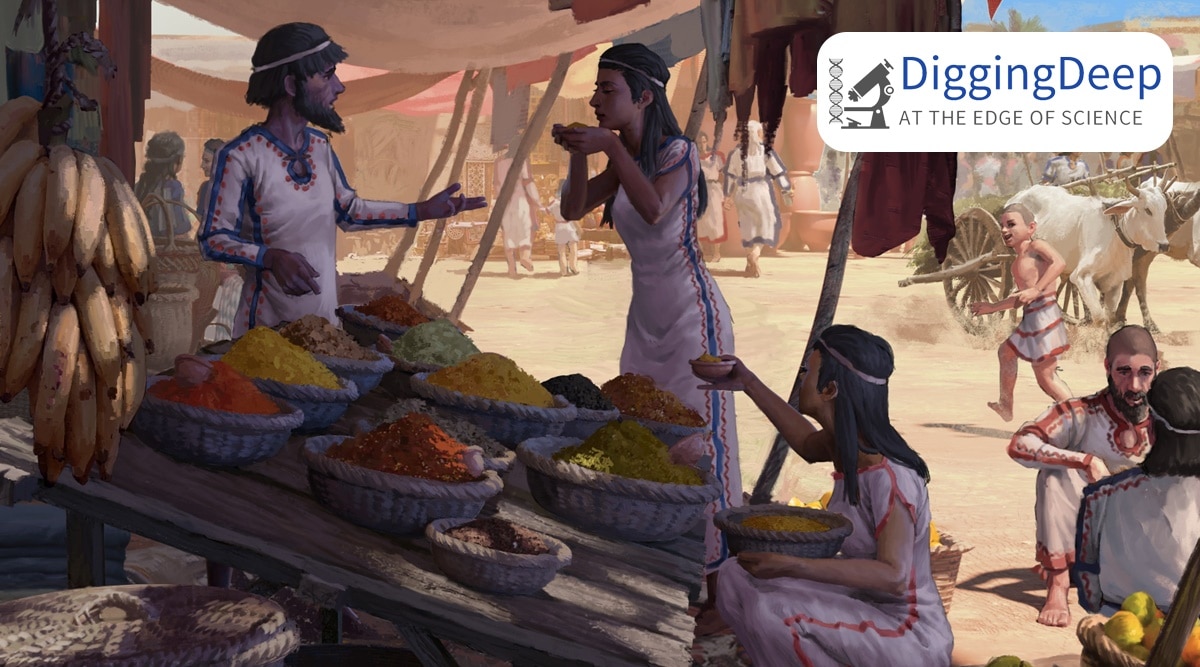 An artist's illustration of a market in the city of Megiddo in the Levant 3,700 years ago (Illustration: Nikola Nevenov via LMU)
An artist's illustration of a market in the city of Megiddo in the Levant 3,700 years ago (Illustration: Nikola Nevenov via LMU) In 1984, the first ancient DNA of the extinct horse ancestor Quagga was sequenced. Ever since, ancient biomolecule research has come a long way and has now become a staple of many archaeological investigations. Biomolecules are organic compounds found in all living cells. The four major biomolecules are lipids, proteins, nucleic acids, and carbohydrates; and the first three are important for archaeological studies.
While DNA was of primary focus in studies up till the late 2000s, studies on ancient proteins are fast catching up because of the remarkable preservation exhibited by them compared to nucleic acids. Proteins can sometimes also offer better resolution than lipid profiles.
A study published in PNAS employs ancient proteins in archaeological contexts to establish trade links between the Southern Levant (modern-day Israel, Jordan, Palestine, Syria, Lebanon) and South Asia as far back as Middle-Late Bronze Age (~2000-1200 BCE) and Iron Age (~1500-1200 BCE).
In particular, the study focused on human burials from two sites in Israel: Megiddo (1800-1500 BCE) and Tel Erani (1100-1000 BCE). The study reports the recovery of dental calculus or stains on teeth from 16 individuals (13 from Megiddo, 3 from Tel Erani), which were then used for protein and micro-remain analysis.
The protein signatures on the teeth were identified as those of common bread wheat, barley, soybean, sesame, banana and turmeric. The finding is significant as it establishes the consumption of food crops that were exotic to the Eastern Mediterranean diet, well before they were documented in writing and art.
The team also analysed phytolith residues in dental calculi. Phytoliths are microscopic silicaceous remains originating in plant tissues and are preserved in teeth and enamel. The phytoliths were identified to have been derived primarily from wheat and millets, and to a lesser extent, from date-palm. The aforementioned millets were considered to be Asian broomcorn or foxtail millets by the authors of the study, as they are known to have reached the Levant via Central Asia by the third millennium BCE.
Unexpected finds
Wheat and palm were expected finds, as wheat was domesticated in Turkey/Near East around ~10000 BCE and palm is indigenous to the region. But sesame is a non-local domesticate and attests to trade links between Asia and the Levant. The oldest sesame seeds have been found in the Indus Valley, and the researchers maintain that sesame had become an important oilseed crop in the Eastern Mediterranean by the Bronze Age.
The discovery of consumption of soybean, banana and turmeric was also completely unexpected. Soybean does not have any record of cultivation in the Mediterranean prior to the twentieth century, and its center of domestication lies in Central China. Soybean, like sesame, constituted a major oil plant of the Levant food basket, and exotic oils have been abundantly mentioned in ancient Mesopotamian and Egyptian texts. Besides, oils can be easily transported over long distances.
Thus far, banana has largely been identified in the archaeological world through phytoliths or textual/artistic evidence, as domesticated banana is seedless and does not leave any seed remains in the ancient record. This makes banana protein identification quite noteworthy, because earlier identifications of banana in the Eastern Mediterranean, such as the desiccated fruit pulp recovered in a 1500 BCE Egyptian tomb, have been highly contested. The authors conclude that this firmly places the banana in the Levant by the first millennium BCE.
Turmeric tale
Turmeric has been consumed in South and Southeast Asia since at least the late third millennium BCE, with cattle dental calculi and pottery from Indus Valley sites (~2600-2200 BCE) yielding turmeric starch grains. The turmeric protein identification at Megiddo, interestingly in the dental calculus of the same person who used soybean – and who was probably a trader himself – indicates its arrival in the Levant by the Bronze Age. Some earlier studies have strengthened the case for Indo- and Sino-Mediterranean trade links, operating through the Indian Ocean via the Red Sea and the Persian Gulf, well before the advent of writing and script.
The article notes that this exchange continued to take place throughout the second millennium BCE (Bronze Age), a time when India went through considerable political restructuring: Indus Valley was on its last legs and the Gangetic Kingdoms had taken root.
For instance, organic residue analysis from Eastern Mediterranean archaeological contexts has yielded signatures that are similar to those of cinnamon, nutmeg, and jasmine – all Asian crops. The burial context of Ramses II (Egypt, 1213 BCE) yielded peppercorns from South India and cloves from Indonesia.
These studies highlight the growing importance of biomolecular signatures in ancient contexts predating the advent of writing, even as textual evidence often tends to ignore culinary exchange, and tends to centre on the movement of durable goods and animals. Biomolecular evidence holds the potential of superseding even macro botanical evidence, as the latter tends to be biased towards plants that survive better.
– The author is a freelance science communicator
- The Indian Express website has been rated GREEN for its credibility and trustworthiness by Newsguard, a global service that rates news sources for their journalistic standards.

